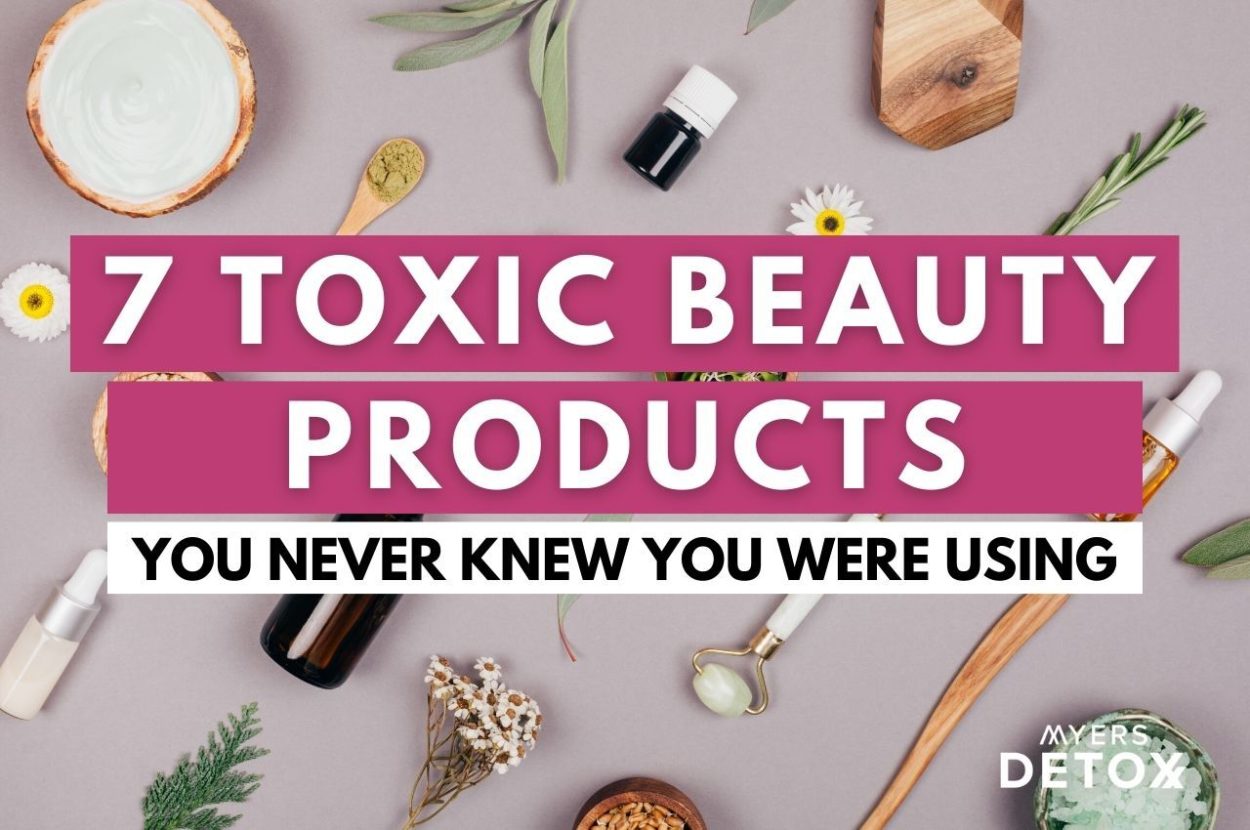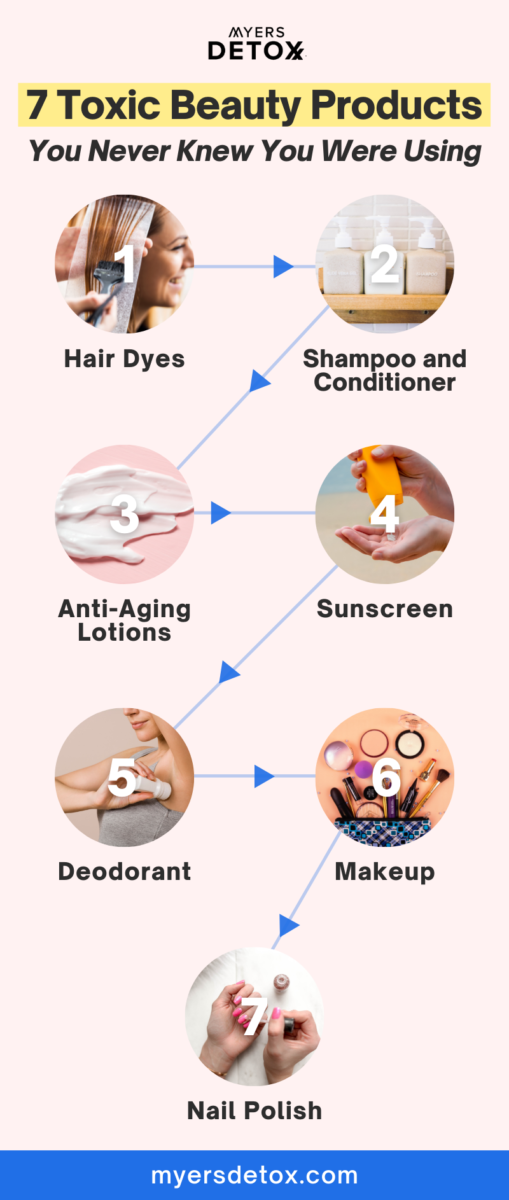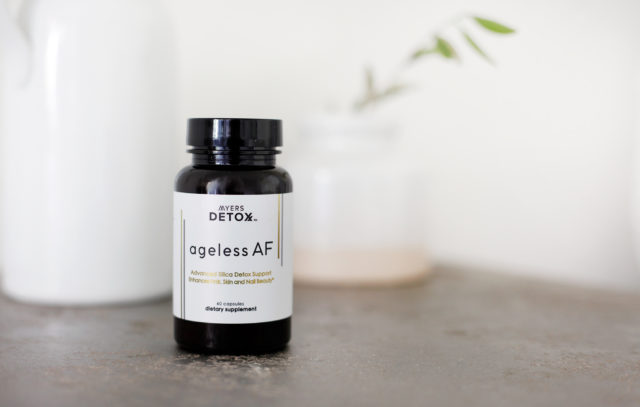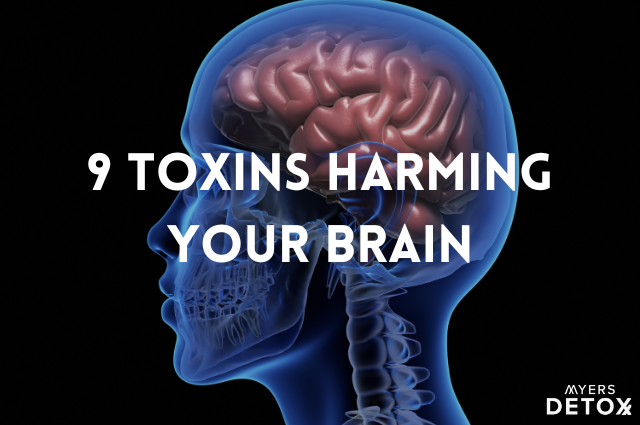Cleaning up your diet can make a huge difference in how you look and feel. Eating high-quality, organic meat and vegetables does wonders for your skin, supports your organs, and provides your body the clean fuel to keep you going.
However, if you’re not extending the same scrutiny to your personal care products as you do to your food, you may be in for diminishing returns.
Discover the 7 toxic beauty products you never knew you were using in this article!
It’s commonly assumed that the products you apply to your skin are safe because you’re not ingesting them. What many people don’t realize, however, is that your skin is an organ that can readily absorb chemicals. As living tissue, when your skin comes into contact with certain chemicals, they may penetrate deep into the layers and travel down, eventually reaching your internal circulation. From there, they have free reign to corrupt any tissue in your body[1].
So, how safe are your beauty products?
To shed a little light on the growing issue of harmful chemicals in personal care products, the EWG states that “Since 2009, 595 cosmetics manufacturers have reported using 88 chemicals, in more than 73,000 products, that have been linked to cancer, congenital disabilities or reproductive harm.”
In this article, I’ll highlight:
- The top 7 toxic beauty products you likely use every day
- The most dangerous chemicals that are slowly poisoning your organ systems
- Why anti-aging lotions are anything but
- Why the health of your reproductive system is in severe danger until you switch your beauty products
7 Toxic Beauty Products You Never Knew You Were Using
#1 Hair Dyes
Women have been using hair dyes to switch up their style or cover up graying hair for over 100 years. There’s just something refreshing about going to your hairstylist and walking out with a fresh look. Unfortunately, hair dyes are one of the most toxic beauty products you could find.
In fact, hair dyes have been under scrutiny for a while due to studies linking the use of permanent and semi-permanent hair dyes and certain types of cancer. While carcinogenic chemicals can be found in all types of dyes, darker hair dyes tend to carry the most potentially threatening compounds[2].
Formaldehyde and bleach are the two most common toxic compounds found in hair dyes. Formaldehyde is a toxic poison that’s well absorbed when inhaled and absorbed readily through your skin. This compound is a known human carcinogen, with research showing a link between formaldehyde and leukemia[13].
Bleach is another poisonous ingredient with side effects that include everything from coughing when inhaled to delirium, slow heart rate, vomiting, and even risk of coma with acute overexposure[14].
P-phenylenediamine is another compound found in hair dye, which has been linked to cancer and organ system toxicity (respiratory and kidney). Furthermore, when reacting with hydrogen peroxide (as it does in hair dyes), it can form a DNA-altering compound called Bandrowski’s base[3].
Resorcinol is another dangerous chemical found in many hair dyes that are linked to endocrine disruption, altering the function of your hormone system. Specifically, resorcinol inhibits enzymes involved in the synthesis of thyroid hormone and impairs thyroid hormone receptors. What’s more, this dangerous chemical can cause organ system toxicity targeting your central nervous system and producing symptoms like fatigue.
Hairstylists are the most vulnerable population when it comes to this type of toxicity, but truly anyone receiving these toxic dyes will carry the chemicals with them, posing a significant threat to their health[4].
#2 Shampoo and Conditioner
Everyday shampoos and conditioners are another significant source of toxic exposure.
Parabens are the most problematic toxin found in shampoo. These compounds can mimic estrogen in your body, causing hormonal havoc and potentially setting the stage for breast cancer. Research also shows that parabens can reduce sperm production in men, and can alter the function of reproductive organs in women[15].
Similar to hair dyes, shampoo and conditioner are another potential source of the endocrine disturbing compound resorcinol[4].
As mentioned, resorcinol inhibits enzymes involved in the synthesis of thyroid hormone and impairs thyroid hormone receptors. In addition, it can cause organ system toxicity targeting your central nervous system.
Furthermore, a compound called benzophenone, which can be found in a range of personal care products is often used in shampoo and conditioner to protect fragrances and colors from losing their potency due to UV light. Benzophenone falls under California’s proposition 65 for its potential carcinogenic activity and is known as an endocrine disturbing compound for its potential to mimic estrogen — potentially leading to breast cancer.
In rats, benzophenone causes liver hypertrophy and has been shown to permeate through the skin and accumulate in the blood, liver, and kidneys[5].
#3 Anti-Aging Lotions
Anti-aging lotions have become incredibly popular as the cosmetics industry has led many of us to believe that anti-aging starts from the outside-in instead of the inside-out. While true science can show us that nourishing your cells with nutrients that give them life can directly impact the appearance of your skin — that message doesn’t bode well for the multi-billion dollar anti-aging skincare industry.
As a result, most women spend hundreds, if not thousands, of dollars annually to lather up with “anti-aging” creams that are laden with dangerous chemicals.
A common ingredient that can be added to your anti-aging lotion is polyacrylamide. Polyacrylamide acts as a stabilizer and binder, with foaming, anti-static, and lubricating properties. As the name suggests, polyacrylamide is made up of repeating units of the chemical acrylamide, which is a suspected carcinogen also found in cigarettes. What’s more, research shows that coming into contact with small amounts of acrylamide on a daily basis, as you would with an anti-aging lotion, may exceed the amount that would result from smoking a pack of cigarettes a day.
In addition to its potential carcinogenic activity, polyacrylamide is linked to reproductive and developmental toxicity, impacting both males and females. In the EU, polyacrylamide is heavily regulated, but there are no regulations for this compound In the United States[6].
#4 Sunscreen
Right along the lines of anti-aging, if you’re trying to avoid wrinkles, you must combat public energy number one — UV rays from the sun. And of course, the best way to do this is by using sunscreen.
Most sunscreens work by blocking UV rays from the sun via UV filter ingredients. One UV filter that’s commonly found in sunscreen is octinoxate, also known as Octyl methoxycinnamate (OMC). OMC can be absorbed rapidly through your skin, and research shows that this chemical can be detected in urine, blood, and breast milk.
Octinoxate may do a fantastic job of protecting your skin cells from sun damage, but it comes at a price — endocrine disruption. This chemical not only mimics estrogen in your body but also disrupts the function of your thyroid. Studies show that exposure to octinoxate may disrupt the reproduction and development of fetuses, and it alters the weight and function of reproductive organs in animal studies[8].
Another ingredient that protects against UV light in sunscreen is oxybenzone, a derivative of benzophenone. As previously mentioned, benzophenone is a known endocrine disrupter and falls under California’s prop 65 order due to its potential carcinogenic activity. As a compound that can mimic the effects of estrogen, benzophenone may increase the risk of breast cancer. Furthermore, benzophenone is suspected to be toxic to your organs, especially the liver[5].
What makes benzophenone and oxybenzone so dangerous in sunscreen is that this chemical is easily absorbed by your skin, giving it free passage to your bloodstream and organs.
#5 Deodorant
If you’ve ever perused the natural deodorant section at your local health store, you’ve likely seen the words “aluminum-free” plastered across the packaging. Aluminum is the most well-known toxic compound found in deodorants, but it’s far from the only one. Aluminum, which is a toxic metal, is part of the “antiperspirant” activity in deodorant as it helps to prevent sweating. While the importance of allowing your body to sweat naturally could be an article all on its own — just understand that introducing a chemical into your body that stops its natural function is never a good idea.
In addition to toxic heavy metals, however, common deodorants include a host of other potentially dangerous chemicals. One such chemical is triclosan, an antibacterial ingredient that serves to kill bacteria and prevent bad odors.
It may sound like a good deal, no smelly armpits? Great. But triclosan has been linked to hormonal dysfunction, including increased estrogen and testosterone, along with a disruption in thyroid hormone activity. What’s more, cell cultures indicate that when treated with triclosan, breast cancer grows and multiplies at a faster rate[9].
#6 Makeup
Us ladies love all of our beautifying foundation, mascara, blush, eye shadow, eyeliner, lipstick, and more. But are we dying to be beautiful?
Your makeup be one of the toxic beauty products affecting your health!
Conventional makeup companies load up their products with chemical compounds that enhance the texture, smell, and color of their makeup with little regard for how those ingredients may be impacting your health.
Many foundations include nanoparticles, which may cause organ system toxicity as they can stay on your body for up to 6 months once absorbed. Some research suggests that low solubility nanoparticles are more toxic than larger particles of the same material due to the ease at which smaller particles can be absorbed or ingested.
Titanium dioxide nanoparticles and may cause inflammation in the lungs when inhaled, along with DNA damage. And nanoized silver may lead to oxidative stress resulting in cell damage. Silver is specifically concerning for males, as some research suggests that it is toxic to the male reproductive system, reducing sperm count due to its ability to cross the blood-testes barrier[7].
And benzophenone, the potential carcinogen and endocrine disruptor mentioned in the section on anti-aging and sunscreen can be found in lip balms and foundations[5].
Meanwhile, color cosmetics often contain phthalates which have been banned by the EU yet remain an active ingredient in many US-based makeup brands. Phthalates have been linked to cancer, hormone imbalance and disruption, and developmental and reproductive toxicity[10].
Formaldehyde is another dangerous compound that may be lurking in your water-based makeup products as it prevents microbes from growing. Formaldehyde is a tricky one because it can be added directly to your products or released as a byproduct from preservatives. Regardless of how it got there, this harmful compound is a known carcinogen that’s either banned or heavily regulated in many countries, excluding the US[11].
#7 Nail Polish
You may overlook nail polish as a potential source of toxic compounds because it’s applied only to your nails, and is, therefore, less likely to absorb into your body. However, the issue with nail polish is the strong fumes that it produces that can easily be inhaled.
And if that smell is any indication, it’s not a stretch to assume nail polish is loaded with highly toxic chemicals.
In addition to some of the previously mentioned culprits like nanoparticles, phthalates, and formaldehyde, another common chemical added to nail polish is toluene. In nail polish, toluene is used to suspend the color of the polish and help it form a smooth finish across your nails.
Acute exposure to toluene may result in dizziness and headaches, but chronic use is associated with much more sinister effects such as central nervous system dysfunction, respiratory issues, developmental issues, and toxicity to the immune system.
Toluene has been found to be unsafe for cosmetics as determined by the Fragrance Association Codes and Standards and is restricted for use in cosmetics in the EU, but this hasn’t stopped many nail polish manufacturers from using this harmful compound[12]. For safe nail polish recommendations, check out this article.
Clean Beauty Products: Your Natural Solution
After learning about the potent toxicity that’s hiding in almost every beauty product out there, I took it upon myself to figure out how I can keep my favorite beauty routines without slowly poisoning myself.
Living a toxin-free life is my passion, so to say I went deep into finding the best options out there would be an understatement.
From my personal research and feedback I’ve received from friends, family, and clients, I have found two companies that I can fully throw the weight of my support behind when it comes to natural beauty care products.
These include:
#1 Wellnesse
Wellnesse is a product line formulated by Katie Wells, also known as Wellness Mama. Much like myself, Katie has devoted her life to finding the best options for clean living and finally decided to cut through all the chaos by creating her own line.
Wellnesse offers a range of shampoos and conditioners that are made with natural, clean ingredients. In addition, she has a fantastic moisturizing hand sanitizer and whitening toothpaste.
#2 Annemarie Gianni
Annmarie Gianni offers a full spectrum of skincare and haircare products. You can find everything from shampoo and conditioner to make up to anti-aging creams and much more. Truly, it’s a one-stop shop for beauty products.
Everything in this product line is carefully formulated and manufactured to include only the highest quality ingredients — and believe me, it shows. The line is natural, organic, and wild-crafted, so you can be sure that no sneaky fillers or unwanted chemicals are lurking in the mix.
#3 Primal Life Organics
Primal Life Organics offers a sumptuous line of paleo, vegan, and gluten-free beauty care products. It was founded by Trina Felber, a nurse with 29+ years of experience and a Masters in Nursing Anesthesia, and the international best-selling author of Beauty’s Dirty Secret. She is dedicated to helping others realize the dangers in everyday cosmetics and skin care, and spreading awareness for the importance of using plant-based, nutritional skin care products. The loving care that goes into her products really shines through.
For more recommendations on natural beauty products, please visit here, here, and here.
Beauty From Inside Out
I’ll be the first to admit that using beauty products can enhance the look and feel of your skin. However, if you want to make lasting changes or maintain a lasting glow, you must work on your beauty routine from the inside out.
The nutrients you consume eventually end up becoming the stuff that your cells are made of. Therefore, if you consume unhealthy low-quality foods, you’re going to have unhealthy skin. On the other hand, if you consume a diet rich in nutrients, it will show up on your face as a healthy glow and complexion.
With that being said, there are specific nutrients that offer targeted support to your skin cells that I recommend focusing on if anti-aging is your goal—specifically silica, biotin, hyaluronic acid, selenium.
These four nutrients provide the structure, integrity, glow, and elasticity that takes years off your face — and it all happens from the inside out.
In addition to using natural beauty care products, I don’t miss a day of supplementing with these nutrients, which is why I created Ageless AF, so I could get them all in one place.
Much like the skincare and haircare companies I recommend, I went through a rigorous process to make sure that I was only sourcing the highest quality ingredients for Ageless AF and that the end product was allergen-free and non-GMO.
If you’re looking for a non-toxic way to promote anti-aging and support your skin from the inside-out, grab a bottle of Ageless AF today.
The Takeaway on Toxic Beauty Products
Finely crafted marketing will lead you to believe that the only way to enjoy young, glowing skin is to lather yourself up with creams and lotions that are loaded with toxic compounds.
Furthermore, everyday products like deodorant, makeup, nail polish, and hair care products are infused with chemicals that are associated with endocrine disruption, developmental issues, and organ system toxicity.
You won’t see any warnings on the labels, and the disturbing amount of toxic compounds in your products aren’t being blasted on the evening news. This is why it’s crucial that you become your own self-advocate.
Take a look at your bathroom cupboard and toss out anything that includes the toxic ingredients mentioned above. And to be safe, check out companies like Annmarie Gianni and Wellnesse and Primal Life Organics for your natural beauty product needs.











